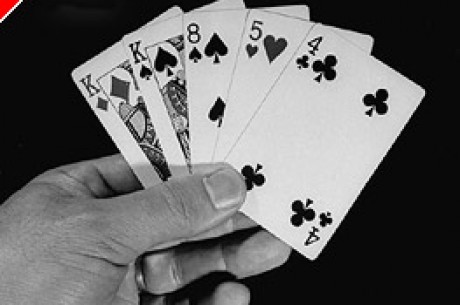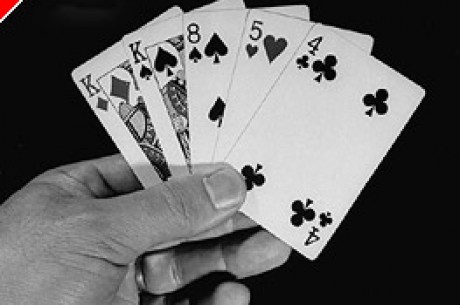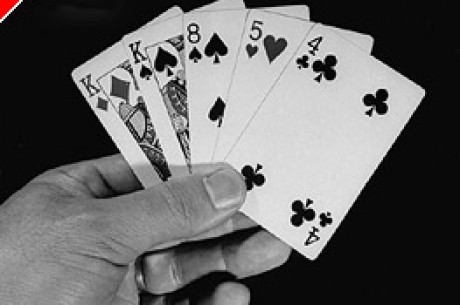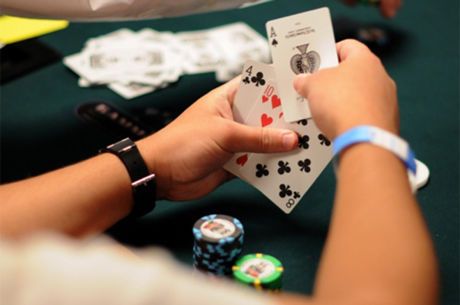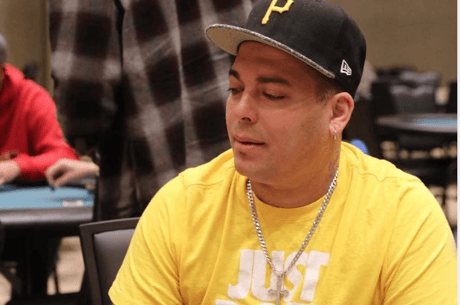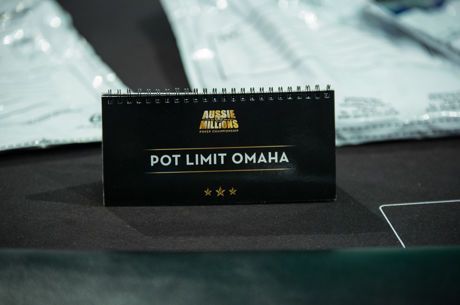Introduction to Omaha - part 17 - Pot Limit - Paying To Learn
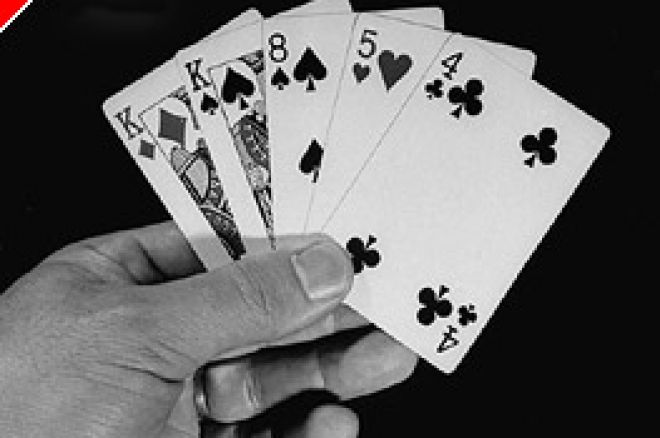
Tony is a regular on-line and card room player living in England. He mostly plays Texas Hold'em and Omaha (High and Split) at fixed, pot and no limit, at both cash and tournament tables.
Introduction
I have talked a lot about the basics of Omaha, the characteristics of its hands and what you should think about playing, especially at limit stakes. I have introduced pot limit and how you should be less inclined to see flops with marginal hands because of the potential to cost yourself your entire stack in one misplayed hand.
In contrast, at pot limit Omaha, there is a case for re-raising the pot simply to blast your opponents off their own marginal hands, in the right situation. You must also remember that, in Omaha, you can often be the favourite after the flop holding a multiple drawing hand (but having nothing made) against someone holding the nuts at that stage. In such a case, you have to take your courage in both hands and re-raise hoping to reduce the numbers in the field and outdraw your remaining opponent(s). After the flop, you could have between 15 and 21 possible outs from two cards which is a favourable situation for you against one and maybe two opponents.
For now, I will play a game of pot limit Omaha on-line. I will do as I did for the limit examples and play it on a small stakes table. This time I will play at Pokerstars.com on a $0.25/$0.50 pot limit table. These allow a maximum $50 stake to start with. This time I will not publish the hands I fold before the flop but you can take it from me that many of the hands I receive are folded. Instead, I will talk about the hands of mine that develop and see what I can glean from the play.
Lessons can be expensive
There is one full table at this level currently so I am first in line on the waiting list. It will give me a chance to see what the players are like. Having watched a few hands, there are clearly some who like to call and one or two who make the minimum raise, which I don't like to do in this game. Either you raise to narrow the field or you don't raise at all. A minimum raise will still attract limpers for the ride and it could be one of their mediocre hands that draws out on you on the flop.
Finally I'm in and the cards are dealt:
Action hand 1:
The first hand of interest that develops occurs without me but I will recount it as a warning to limpers. I have 8d 3d 8h 7s. It is a poor starting hand with a bare mid-sized pair and no support, but players often limp in with any pair. I fold and the flop comes 4 8 J. This type of hand would immediately suck a player into betting the set. In practice, one person raises and another re-raises. I immediately wonder whether the re-raiser holds JJxx with such a strong bet on a raggy flop. Ultimately, the river is a J which would have made me a full house 8's over J's. It would have been tempting to bet out here because the two J's on board makes it less likely that the re-raiser holds the other two J's. However, the re-raiser does have them and makes quads!
Lesson learned:
A bare middle pair is often a dangerous hand to see a flop with. Middle sets are weak in Omaha. Always fold shabby hands before the flop. It will save you a fortune.
Action Hand 2:
In the small blind I get Qh 9d Tc Ac. This offers a nut flush potential and a straight, although the latter needs a K + J or a J + 8 combination to appear on the board. We need a nice flop. It comes 9s 5c 2c offering the nut flush draw and top pair on a raggy flop. This suggests I should be able to get a cheap look at the next card unless someone has caught a set (but the 9's are unlikely as I have one myself). I am first to bet so I pot raise $3.35. I don't mind closing it out here as I am still odds against making the flush. It doesn't put the limpers off and I receive three callers which builds the pot nicely. The turn is Qc - perfect! It also makes me top two pair giving me four possible cards for a full house on the river. With the nuts already in hand, I only want to avoid a 9, 5 or 2 on the end to be guaranteed the pot. The thing now is how to keep players in. I decide to bet a third of the pot, $5. I get one caller. The river is a red 6 so I have the nuts. I now have to weigh up how to get the maximum pay-off without scaring my opponent away. I suspect he has a flush too since he was not afraid of my turn bet (or perhaps he has 99 or QQ). It is possible he thinks I do not have an ace as my turn bet was quite small. I decide to bet $20. He calls and I take down a $63 pot.
Lesson learned:
From the point of view of the caller on the end, it is the old adage in Omaha, "Always fear the nuts". If he held the K flush, the call was probably understandable as he might think I was trying to buy the pot. From my viewpoint, the draw being caught on the turn made it easy. With a flush, you have to be aware of paired boards. Had a pair come on the end, I would have been the one fearing the nuts!
Action Hand 3:
In late position I get Ad Js 8c Ac. Two aces is a traditional raising hand and it is often what someone has if they re-raise the pot. Nonetheless, you don't want to be up against a lot of players when the flop comes so it is not a limping hand unless you are in early position and are confident someone will raise ahead of you and you can then re-raise them. In this case, someone has raised to $3 and I decide to re-raise the pot of $8. The raiser has $40 in total available and I suspect that will be my commitment to this pot. He finally calls, suggesting a lesser hand or good draws only. The flop is Tc 9d 9s, not the best with a pair there. However, the benefit of raising pre-flop is to narrow the chance of someone catching a set like this. It would be very unfortunate for me if this one caller happens to have one of the remaining two 9's or a pair of 10's. He checks which I take to be a good sign rather than a slow-play. I decide I would like to take the pot here and bet the $16 pot. I also have J 8 for an open-ended straight draw. My opponent however re-raises for most of his stack so he is almost all-in. This is not a good sign at all but I have a dilemma since I know my downside is limited to another $18. I assume he is holding a set and not a full house so I have 11 outs for a straight or better. I think I have to call him. The turn is a third 9! Now I have a full house 9's over A's. The river is an 8. He shows QQ9x for the quads.
Lesson learned:
In this case, the check-raise on the flop screamed a set or better. Two things prevented what should have been an easy lay-down. First, the maximum I could lose was another $18 rather than the $100+ if we were deep-stacked. That gave me a better risk reward profile. Second, I also had 8 outs for the straight. As it happens a Q for a straight would have made a full house for the opponent (without the third 9) but I was not to know that. It is, however, too easy to play aces through to the end simply through over-valuation after the flop has come down.
Conclusion
There is no getting away from the fact that pot limit Omaha is a volatile game with large pots being contested by players willing to go all-in with what they perceive to be a better than 50% chance of winning the pot. This is the correct action of course. So long as your big bets are stacked slightly in your favour, you will win overall. The virtual circle that you are seeking to create is the building of a large chip stack with which you can start to bully smaller stacks off their draws. Then the advantage swings further your way.
The above hands are but a small sample of how significant decisions can affect your stack size. If you can cut out the leakages when the odds appear to be going against you but maximise the take when they are in your favour, you will build big stacks more often.
Ed Note: Great Omaha action always at Doyle's Room

